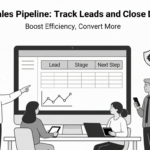Sales CRM Explained: Streamlining Your Pipeline for Higher Conversions
19 Dec, 2025
Most SMBs don’t struggle with leads—they struggle with what happens...
Updated: 19th July, 2025

Yamuna Manthan 2025 – A Thoughtful Step, A Collective Promise
Today we are going to discuss something that’s near and dear to our hearts — our rivers, particularly the Yamuna. What was announced in Delhi the other day was not merely a summit, it was a movement — with hope, with urgency, and with collective action.
What was Yamuna Manthan 2025?
On July 11, 2025, at the Dr. Ambedkar International Centre in New Delhi, the MAS Council for Water and River (MCWR) organized Yamuna Manthan 2025 — a beautiful gathering of scientists, students, policymakers, water experts, and changemakers from across India and the world.
And it had just one goal:
“How can we bring life back to our Yamuna?”
This wasn’t just an event. It was a shared moment of reflection, of action, and of dreaming about a cleaner, living river.
The answer is simple, and painful.
Our beloved Yamuna — sacred, cultural, essential — is dying.
And here’s what we’re facing:
So yes, the summit was necessary. Because if not now, then when?
The reality of Yamuna today
Let’s be honest — standing by the river today doesn’t feel peaceful.
You don’t hear flowing water; you see sludge.
You don’t smell fresh air; you catch a stench.
And yet, despite all this, there is hope.
This summit reminded us that we still have the power to turn things around — together.
What can a summit like this really achieve?
Much, actually. Since change begins where minds come together.
Yamuna Manthan 2025 was never about speeches — it was all about devotion.
What that sparked was:
A shift in the public discourse — from blame to ownership
Wisdom from key voices
The summit was graced by some incredible thinkers and doers — people who’ve spent years working to understand and heal our rivers. Their words reminded us that saving the Yamuna is both a scientific mission and a moral responsibility.
“Yamuna’s water levels, floodplains, storage, and drainage systems have been impacted for at least the past 150 years. Fragmented flow paths, water diversion channels, and resulting shifts have altered the river’s natural course.”
“Whether we like to hear it or not, we are a self-centred species. We need to find ways that serve our needs while also protecting the environment.”
“Cleaning a river is difficult, but it’s not rocket science.”
“Restoring Yamuna’s natural floodplains is critical. A river cannot survive if its physical space is destroyed.”
“We want to gather ideas and act as a platform — a network that empowers those who want to contribute.”
“Without restoring Yamuna’s natural flow and making deep institutional changes, river rejuvenation will stay a distant dream.”
“Japan revived its rivers through science and collaboration. We’re proud to partner with India to do the same for Yamuna.”
“We need to combine traditional knowledge with modern science. Both are essential.”
“Educational institutions must shape not just scholars, but eco-conscious citizens.”
“Recharging groundwater isn’t optional anymore — it’s critical for Yamuna’s survival.”
A play that touched every heart
One of the most emotional moments of the day was a street play performed by Delhi University students titled:
“Hamari Yamuna, Hum Bachayein” (Our Yamuna, Let’s Save Her)
It wasn’t just a performance — it was a wake-up call.
The students showed:
The power we hold — when we act together
A Grateful Commitment
At Groweon, taking part in the Yamuna Manthan 2025 was more than attendance — it was coordination.
We’ve never believed sustainability is a department — it’s an ethos.
It rests on three pillars:
This summit reaffirmed our resolve for clean rivers, responsible living, and a truly sustainable India.
Let’s not wait for more summits. Let’s be the movement. Rivers do not need empathy — they need us.

19 Dec, 2025
Most SMBs don’t struggle with leads—they struggle with what happens...

18 Dec, 2025
Cold calling still works in 2026—but the teams winning aren’t...

18 Dec, 2025
Sales is one of those words everyone uses, but very...

17 Dec, 2025
Most sales teams don’t lose deals because of price or...

16 Dec, 2025
Sales is one of those words people use every day...